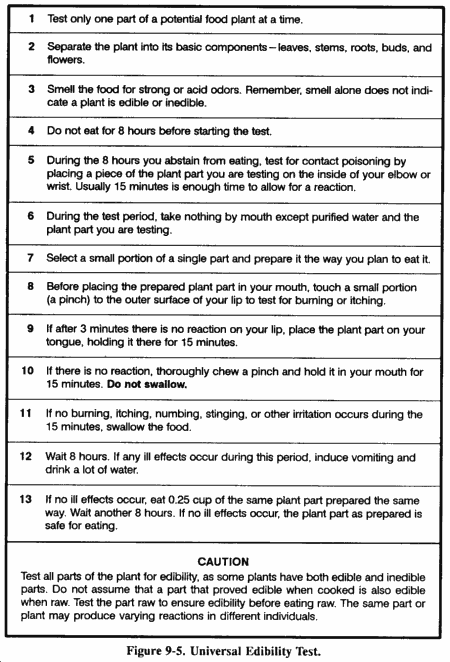It's important to start your testing early because many of these test take time. Some are over 24 hours! So don't drive yourself into starvation mode. Start testing out your plants before you run out of food. So in other words, don't procrastinate. Also, start with the plants that you see the most of. If you pick some berries to test out and they seem to be sparse, it's a waste of time because even if they're safe, they won't be enough to sustain you. So think smart!
Remember, eating large portions of plant food on an empty stomach may cause diarrhea, nausea, or cramps. Two good examples of this are such familiar foods as green apples and wild onions. Even after testing plant food and finding it safe, eat it in moderation.
You can see from the steps and time involved in testing for edibility just how important it is to be able to identify edible plants.
To avoid potentially poisonous plants, stay away from any wild or unknown plants that have–
- Milky or discolored sap.
- Beans, bulbs, or seeds inside pods.
- Bitter or soapy taste.
- Spines, fine hairs, or thorns.
- Dill, carrot, parsnip, or parsleylike foliage.
- “Almond” scent in woody parts and leaves.
- Grain heads with pink, purplish, or black spurs.
- Three-leaved growth pattern.
- Using the above criteria as eliminators when choosing plants for the Universal Edibility Test will cause you to avoid some edible plants. More important, these criteria will often help you avoid plants that are potentially toxic to eat or touch.
An entire encyclopedia of edible wild plants could be written, but space limits the number of plants presented here. Learn as much as possible about the plant life of the areas where you train regularly and where you expect to be traveling or working. Listed below and later in this chapter are some of the most common edible and medicinal plants.

Thanks for the information, Wilderness Survival Net! Because this comes in an easy to follow guide, we recommend that you print it and place a copy in your wallet or possibly your Bug-Out-Bag so you have it in the event of an emergency and you are not left having to rely on memory.
Do You Have a Special Way to Test Plants from the Wild for Safety?
If you or someone you know has learned a special way to test certain plants or bugs for consumption safety, let us know! We hope scenarios where this would be necessary do not come our way, but it's always better to be prepared than caught off guard.
